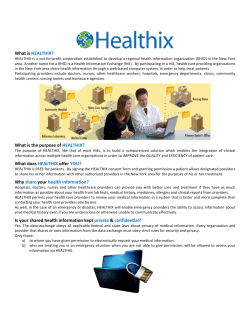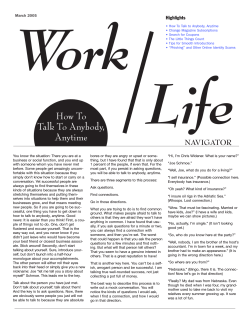
IDeNTITy ThefT TooL KIT How to protect yourself against identity tHeft
identity theft tool kit How to protect yourself against identity theft Contents What is identity theft? 3 How can someone steal my identity? 4 Protecting yourself against identity theft 5 How can I tell if I’m a victim of identity theft? 7 What do I do if I’m a victim of identity theft? 8 Resolving identity theft-related credit problems 10 Sample dispute letter 11 Identity theft risk assessment 12 Important information and contacts 14 Identity theft is one of today’s fastest growing crimes. At Macquarie Bank, we are fully committed to fighting identity theft and arming you with all of the facts that can help you avoid becoming a victim. | identity theft tool kit What is identity theft? Identity theft is when someone takes and uses your personal information such as name, address, date of birth or mother’s maiden name to commit theft. With enough personal information, thieves can: •Withdraw money from your bank accounts, including by internet and over the phone. •Open new bank accounts in your name such as cheque and credit card accounts. •Establish home phone or mobile phone accounts. •Take out mortgages and car loans. •Damage your credit rating. •Commit crimes under your name. •File for bankruptcy under your name to avoid paying debts. identity theft tool kit | 3 How can someone steal my identity? Identity thieves can access your personal information by: •Obtaining credit reports by posing as a landlord or employer. •Stealing personal information from your home. •Stealing wallets and purses. – stealing records from their employer •Stealing mail from your letterbox, including bank and credit card statements, utility bills, chequebooks or tax information. – bribing an employee who has access to the records •Completing a ‘change of address form’ to divert mail to another location. – conning information out of employees •Obtaining information directly from you by posing as a legitimate businessperson or government official. •Getting information from businesses or institutions by: – hacking into the organisation’s computer systems. •Obtaining information from you on the Internet or via email by posing as a company with whom you have a relationship, known as phishing. •Going through rubbish outside your home, businesses or local authority tips. | identity theft tool kit •Internal data compromise within companies. Protecting yourself against identity theft If you become a victim of identity theft, you could end up with big bills, a bad credit rating and on average, 400 hours of work to sort everything out! It pays to reduce your risk. Protecting personal information •Lock all personal documents somewhere safe when not using them. •Don’t carry personal information outside your home unless you really have to. •Ensure you have a secure lockable letterbox. •Tear, cut up or shred all old records, files, bills, expired credit cards or other cards before putting them in the bin. •Don’t respond to suspicious mail or email. •Don’t store personal details on mobile phones. •Avoid giving personal or financial information over the phone. •Install caller ID on your phone and record the numbers of unusual calls. •Check your credit statements monthly and your credit file every six months. identity theft tool kit | Protecting yourself against identity theft continued Protecting personal information on your computer Protecting your personal financial information •Use passwords and access controls. •Order a copy of your credit report regularly. •Avoid giving out personal information over the Internet. •Never click on a link or open an attachment in an email from someone you don’t know and trust. •Regularly install and update anti-virus protection software. •Avoid using public computers to access your personal information. •Beware of emails supposedly from your financial institution asking you to confirm personal or financial information. | identity theft tool kit •Check your billing and account records carefully. •Do not give your personal or financial information to anybody you have not initiated contact with. How can I tell if I’m a victim of identity theft? Some indications of identity theft may include: •Failing to receive monthly statements, bills or other mail. This could mean an address change by the identity thief. •Receiving cards or billing statements for accounts you didn’t apply for. •Receiving calls from debt collectors or companies about merchandise or services you didn’t buy. •Having an application for credit (home loan, personal loan, credit card) declined when you believe you have a good credit history. identity theft tool kit | What do I do if I’m a victim of identity theft? The Macquarie Bank Visa Platinum Card is one of the most secure credit cards available in Australia, and we safeguard and protect your identity by constantly monitoring your card account for any suspicious activity. However, in the unlikely event that you do become a victim of identity theft Macquarie Bank can help. We provide personal support and advice through the process of reclaiming your financial identity and re-establishing your credit. Simply call 1300 150 300 and one of our knowledgeable Customer Service Representatives will guide you through the following steps: 1. Immediately inform the police All incidents of identity theft should be reported to the police even if only small sums are involved. Ask for a copy of the police report – most banks or other financial institutions will ask you for a copy. | identity theft tool kit 2. Alert Macquarie Bank and other banks or financial institutions (if applicable) Cancel all cards and close all accounts that may have been breached. Ask for new cards and accounts with new Personal Identification Numbers (PINs). 3. Get a copy of your credit report Inform the credit reporting agencies that you are a victim of identity theft (see Important Contacts section). Ask that an alert be placed on your file to stop additional fraudulent accounts being opened in your name. 4. Review your credit report carefully Ensure you can authenticate all ‘enquiries’ made into your credit history. Contact all companies and organisations that have made enquiries under your name that you did not authorise. 5. Close all unauthorised accounts Contact the credit providers and businesses with whom any unauthorised accounts have been opened in your name. Remember, this includes phone and other utility providers and department stores as well as financial institutions. Inform them you have been a victim of identity theft and ask them to close the fraudulent accounts. 6. Keep all documentation Take notes that include dates, names, contact details and what was said with agencies you contact. Follow up all conversations and requests in writing, and send these by certified mail if you need to post them. Keep copies of all forms and correspondence. You can find sample copies of complaint letters in ASIC’s ‘How to complain’ booklet available at www.fido.gov.au. 7. Report loss or theft of documents to the relevant government or private sector agencies Passports – Department of Foreign Affairs and Trade (DFAT) Drivers Licence – your State/Territory Roads and Traffic Authority (RTA) Credit/Debit cards – your bank or other financial institution Mobile Phone – your telecommunications provider Further information on how to prevent and respond to identity theft is contained in the Australian Government’s National identity theft kit. This is available at www.crimeprevention.gov.au under information resources, or by calling (02) 6250 6711. identity theft tool kit | Resolving identity theft-related credit problems Resolving credit problems resulting from identity theft can be time consuming and frustrating. The good news is that there are procedures in place for correcting credit report errors and billing errors, and for stopping debt collectors from contacting you about debts you don’t owe. You have a right to challenge the accuracy of all entries on your credit report and the credit bureau has a legal obligation to investigate every query raised. 10 | identity theft tool kit Sample dispute letter This is a sample letter you can use to dispute false or inaccurate information on your credit report. Areas highlighted in bold can be changed to fit your personal situation. Complaint Department Name of Credit Bureau Address Postcode Your Name Your Address Your Postcode Date Dear Sir or Madam, I am writing to dispute some of the inform ation contained in my credit file. The items I am disputing are circled on the attached copy of the report I received. <Identify item/s disputed by name of source, such as creditors or tax court, and identify type of item, such as credit account, judgement, etc.> This item is <inaccurate or incomplete > because <describe what is inaccurate or incomplete and why>. I am requesting that the item be deleted <or request anoth er specific change> to correct my credit file. Enclosed are copies of <use this sente nce if applicable and describe any enclo sed documentation, such as payment recor ds, court documents> supporting my position. Please investigate this matter and <dele te or correct> the disputed item/s as soon as possible. Please confirm to me in writin g when this has been completed. Sincerely, Your Name Enclosures: <List what you are enclosing.> identity theft tool kit | 11 How vulnerable are you? Take this quick identity theft risk assessment. Please tick the appropriate box. Personal Security Yes/No Do you have more credit cards in your wallet than you need? Have you ever let your credit card out of your sight when paying a bill? Do you leave personal documents lying around? Is your letterbox unlocked? Is there anything in your car glove box that could identify you? Do you put sensitive papers in your household garbage bin? Do you give anyone your credit card details over the phone? Do you buy goods or services on the Internet? Are you forgetting to check your credit report regularly? 12 | identity theft tool kit Computer Security Are you forgetting to change your ISP password regularly? Do you keep personal information on your computer hard drive? Do you forget to regularly update your virus protection? Do you use public access computers? Do you lack personal firewall protection? If you have answered ‘yes’ to any of the above, then you may be at risk of identity theft. Yes/No Important information and contacts Macquarie Bank Cards Tel: 1300 150 300 Police Identity theft should be reported immediately to your local State or Territory police. New South Wales Police Tel: 131 444 www.police.nsw.gov.au Victorian Police Tel: (03) 9247 6666 www.police.vic.gov.au Queensland Police Tel: (07) 3364 6464 www.police.qld.gov.au Western Australia Police Tel: 131 444 www.police.wa.gov.au South Australia Police Tel: 131 444 www.sapolice.sa.gov.au 14 | identity theft tool kit Tasmania Police Tel: (03) 6230 2111 www.police.tas.gov.au Australian Capital Territory Police Tel: (02) 6256 7777 www.afp.gov.au Australian Federal Police Tel: (02) 6223 3000 www.afp.gov.au Northern Territory Police Tel: 131 444 www.nt.gov.au/pfes Credit Bureaus Baycorp Advantage Tel: 1300 762 207 or 13 31 24 www.mycreditfile.com.au Dun and Bradstreet (Australia) Pty Ltd Tel: 13 23 33 www.dnb.com.au Tasmanian Collection Service (for Tasmanian residents) Tel: (03) 6213 5599 www.tascol.com.au General information and fraud prevention bodies The Department of Foreign Affairs and Trade (DFAT) Tel: 131 232 if your passport is lost or stolen within Australia. www.passports.gov.au If your passport is lost or stolen while you are overseas, report to the nearest Australian diplomatic or consular mission. Further information: Australian Institute of Criminology www.aic.gov.au Net Alert www.netalert.net.au Australian Bankers Association www.bankers.asn.au Australian Consumers Association www.choice.com.au The Australian Crime Commission Tel: 1800 088 225 www.crimecommission.gov.au Crime Stoppers Tel: 1800 333 000 mainland Australia Or 1800 005 555 in Tasmania. www.crimestoppers.com.au Centrelink Fraud Tip-off Line: 13 15 24 Report a suspected fraud online: www.centrelink.gov.au Australasian Consumer Fraud Taskforce Tel: Scamwatch 1300 302 502 www.scamwatch.gov.au identity theft tool kit | 15 Contact us on 1300 150 300 or macquariecards@macquarie.com Booklet information source: Dealing with Identity Theft, an Australian Government Initiative. Published by the Australian Government Attorney-General’s Department 2006 © Commonwealth of Australia. Reproduced by permission © Macquarie Bank Limited ABN 46 008 583 542 Australian Credit Licence 237502 (MBL). BKL0202 04/12
© Copyright 2025
















